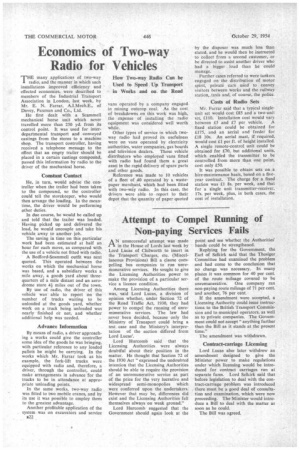Economics of Two-way Radio for Vehicles
Page 56

If you've noticed an error in this article please click here to report it so we can fix it.
THE many applications of two-way radio, and the manner in which such installations improved efficiency and effected economies, were described to members of the Industrial Transport Association in London, last week, by
Mr. E. N. Farrar, of Davey, Paxman and Co,, Ltd.
He first dealt with a Scammell mechanical horse unit which never travelled more than 250 yd. from its control poiht. It was used for interdepartmental transport and conveyed castings from the stores to a machine shop, The transport controller, having received a telephone message to the effect that an empty trailer should be placed in a certain castings compound, passed this information by radio to the driver of the mechanical horse.
Constant Contact He, in turn, would advise the controller when the trailer had been taken to the compound, so the controller could tell the storekeeper, who would then arrange the loading. In the meantime, the driver would be performing other duties.
In due course, he would be called up and told that the trailer was loaded. Having picked up and delivered the load, he would uncouple and take his vehicle away to another job.
The saving in time on this particular work had been estimated at half an hour for each move, as compared with the use of a vehicle not fitted with radio.
A Bedford-Scammell outfit was next quoted. This operated between the works on which the mechanical horse was based, and a subsidiary works a mile away, a goods yard about threequarters of a mile distant and an aerodrome store 41 miles out of the town.
By use of radio, the driver of this vehicle was able to report on the number of trucks waiting to be unloaded at the goods yard, whether work on a truck being unloaded was nearly finished or not, and whether additional help was needed. . .
Advance Information By means of radio, a driver approaching a works could give the controller some idea of the goods he was bringing, with particular reference to any loaded pallets he might be carrying. In the works which Mr. Farrar took as his example, the fork-lift trucks were equipped with radio and, therefore, a driver, through the controller, could make arrangements in advance for the trucks to be in attendance at appropriate unloading points.
In the same works, two-way radio was fitted to two mobile cranes, and by its use it was possible to employ them to the greatest advantage.
Another profitable application of the system was on excavators and service B22 vans operated by a company engaged in mining outcrop coal. As the cost of breakdowns on this work was high, the expense of installing the radio equipment was considered well worth while.
Other types of service in which twoway radio had proved its usefulness were on vans operated by electricity authorities, water companies, gas boards and television dealers. Those vehicle distributors who employed vans fitted with radio had found them a great asset in the rapid delivery of spare parts and other goods.
Reference was made to 10 vehicles of a fleet of 40 operated by a wastepaper merchant, which had been fitted with two-way radio. In this case, the drivers were able to report to their depot that the quantity of paper quoted
by the disposer was much less than stated, and he would then be instructed to collect from a second customer, or be directed to assist another driver who had a bigger load than he could manage.
Further cases referred to were tankers engaged on the distribution of motor spirit, private cars used to convey visitors between works and the railway station, taxis and, of course,,the police.
Costs of Radio Sets
Mr. Farrar said that a typical singleunit set would cost £85 and a two-unit set, 1110. Installation cost would vary between £5 and £7 per vehicle.. A fixed station could be obtained for £175, and an aerial and feeder for 118 10s. An aerial mast, if required, would cost £1 per ft. of height installed. A single remote-control unit could be obtained for £70, but additional units, which enabled the transmitter to be controlled from more than one point, cost only £50.
It was possible to obtain sets on a hire-maintenance basis, based on a fiveyear contract. The charge for a fixed station was 1.1 8s. per week, and that for a single unit transmitter-receiver, 17s. per week, plus, in both cases, the cost of installation.




























































































